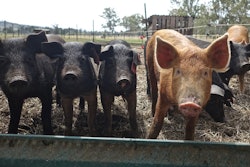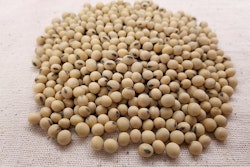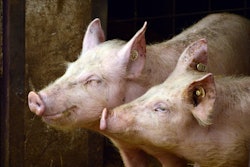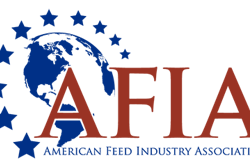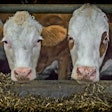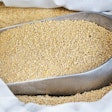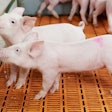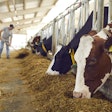
As the International Poultry Council (IPC) took stock of the global protein outlook at its first semester meeting in New Orleans, LA, last week, one economic reality riveted attention: Total world production of pork will decline in 2019 with poultry in position to wrest the crown from pork as the world’s most consumed meat protein.
The upheaval in meat proteins is being driven by African swine fever (ASF) in pig herds in three continents and 15 countries. Production losses in 2019 are expected to amount to 14% of the world’s pork supply but may continue to move higher.
“Hog losses in China due to ASF will trigger big shocks in global protein markets,” Christine McCracken, senior protein analyst at Rabobank, told IPC members, “and poultry is the meat protein with the most to win.”
ASF outbreaks are ravaging pork production mostly in the Eastern Hemisphere, but the biggest impact is in China where nearly one-half of the world’s pigs are raised. Herds there are being hard hit by a disease that results in 100% mortality of infected stock and for which no vaccine exists.
The disease, which has been in Russia and Eastern Europe for several years, was found in China in August 2018 and is spreading to Southeast Asia and Vietnam (the world’s fifth largest producer of pork). A small outbreak in the European Union has threatened exports there.
“China produces 98% of its pork, so a forecasted 30% decline in supplies there by year’s end will lead to a decline in total world protein supplies in 2019,” McCracken says.
The world will be unable to fill the supply gap in meat proteins, according to McCracken. “Expect imports of all proteins (beef, poultry and seafood) to have limited near-term impact. Prices for all proteins will rise,” she says.
ASF losses will leave China 10% short of meat proteins, but China may be able to increase domestic production of other proteins like eggs, beef, seafood and poultry. “Poultry imports might benefit the most,” she says.
Presiding IPC president Jim Sumner of the U.S. agreed, saying, “African swine fever is decimating China’s leading meat protein industry, and chicken is the logical alternative.”
He pointed to the opportunities for world poultry producers, noting other animal diseases in China like Foot and Mouth and highly pathogenic influenza may further complicate the picture for China’s pork and poultry producers.
Demand destruction for pork
As IPC members listened, McCracken alluded to the potentially historic opportunity for a lasting gain in market share for poultry. “Demand destruction for pork is a potential outcome,” she explains.
Economists at the meeting agreed that poultry consumption will surpass pork consumption on a worldwide basis in 2019. McCracken termed her outlook for a 30% decline in production in China and a 14% decline in world production as “conservative,” saying the declines may be deeper.
“Poultry consumption will indeed surpass that of pork in 2019, and pork will be unlikely to recoup its leadership position,” she says.
Further declines in world pork production of around 3% in 2020 are in McCracken’s forecast as Asia loses more animals and expansion in other regions not in place by then.
“Stabilization will begin in 2021 and a more modest rebound of 1% to 2% in volumes in 2022-2027. Environmental and slaughter constraints are likely to limit the size and speed of expansion,” she concludes.
Dr. Paul Aho predicted pork production will drop 15% worldwide in 2019.
“From there pork will increase 5% per year for four years,” he says. "Then continue increasing at a more modest 2% average per year. Meanwhile, poultry will increase 3% per year for three years (spurred in part by a shortage of pork) before dropping down to an average increase of 2% per year."
“Poultry will surpass pork in production this year and will never relinquish the crown by my reckoning,” Aho says.
Sumner concluded: “With China having lost 30% of its herd to ASF and with it producing 50% of the global supply, there is no doubt that poultry is now king of the meat proteins worldwide.”
Emerging opportunities
IPC members eyed the emerging opportunities and consumer and trade issues around the globe, as they continued to work toward consensus to respond proactively on issues like food safety and antimicrobial resistance, sustainability and the environment, and animal health and welfare.
Canada’s Robin Horel, executive sponsor of the working group on communications and marketing, said IPC is leading the way on consumer and other issues, including working to produce defined positions, aspirations and direction to align the industry globally.
“IPC is leading on these issues by focusing on pre-competitive issues where we can share best practices and where we can have a direct impact through engagement and communication,” he says.
Addressing global barriers to trade is another IPC goal. “The ultimate evidence of our success will be fewer trade barriers and a safer food supply,” Sumner says.
The first semester 2019 meeting marked a milestone as Jim Sumner stepped down as president after leading IPC in that role since its inception in 2005. He will continue to lead the USA Poultry & Egg Export Council as its president.
Horel, president and CEO of the Canadian Poultry and Egg Processors Council, was elected president of IPC. Ricardo Joao Santin, CEO of the Brazilian Association of Animal Protein, was reelected vice president. Sumner was elected treasurer.
The IPC was formed in 2005 by leading poultry-producing countries to determine areas of common interest and develop policies for the overall betterment of the global industry. The organization currently has 29 country members and 56 associate members representing more than 88% of the world’s poultry production and 95% of the poultry trade.

